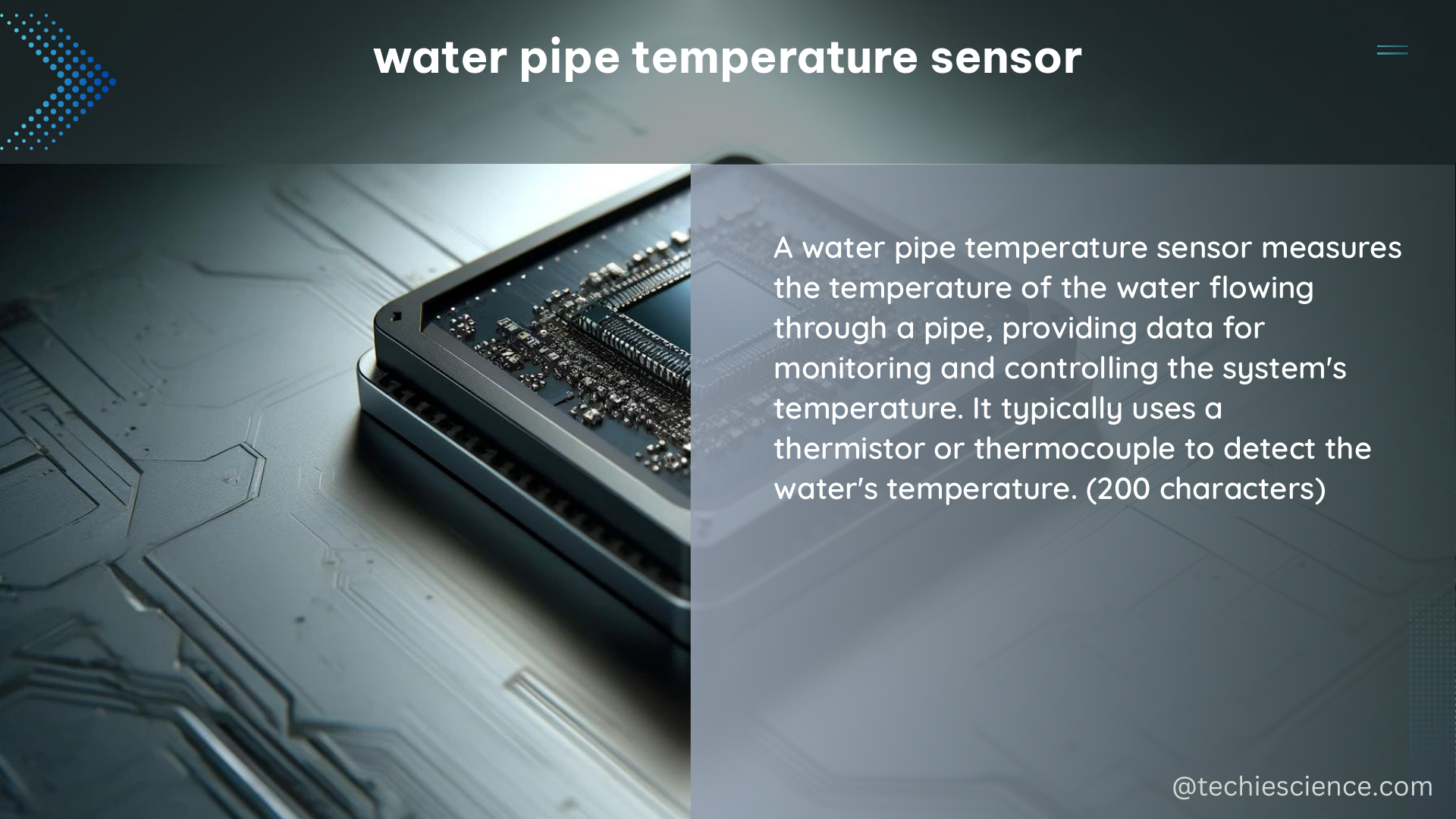Water pipe temperature sensors are essential for monitoring and controlling the temperature of water in various applications, such as HVAC systems, industrial processes, and water distribution networks. These sensors provide measurable and quantifiable data, including temperature readings, response times, and sensitivity levels, which are crucial for ensuring optimal performance and energy efficiency.
Understanding the Technical Specifications
When selecting a water pipe temperature sensor, several technical specifications should be considered to ensure the sensor meets the specific requirements of the application:
Temperature Range
The temperature range of the sensor should be appropriate for the operating conditions of the water system. For example, a sensor designed for a range of -40°C to 120°C would be suitable for most HVAC and industrial applications, while a sensor with a range of -200°C to 500°C would be required for cryogenic or high-temperature processes.
Package Size
The physical size and shape of the sensor package should be compatible with the available space and installation requirements of the water pipe. Compact, low-profile sensors are often preferred for tight spaces, while larger sensors may be necessary for high-flow or high-pressure applications.
Thermal Response Time
The thermal response time of the sensor, which is the time it takes for the sensor to reach a certain percentage (typically 63.2%) of the final temperature, is an important factor. Faster response times are generally preferred for applications where rapid temperature changes need to be detected.
Electrical Response Time
The electrical response time of the sensor, which is the time it takes for the sensor’s electrical output to reach a certain percentage of the final value, should also be considered. This is particularly important for applications where the sensor’s output is used for real-time control or monitoring.
Heat Sinking and Thermal Mass
The sensor’s ability to dissipate heat and its thermal mass can affect its accuracy and stability. Sensors with good heat sinking and low thermal mass are generally preferred, as they can respond more quickly to temperature changes.
Robustness and Compatibility
The sensor should be robust enough to withstand the physical and environmental conditions of the water system, such as pressure, vibration, and corrosive fluids. It should also be compatible with any existing instrumentation or control systems.
Sensitivity, Accuracy, and Repeatability
The sensor should have high sensitivity, accuracy, and repeatability to ensure reliable and consistent temperature measurements. This is particularly important for applications where precise temperature control is required.
Power Dissipation and Interchangeability
The sensor’s power dissipation should be low to minimize its impact on the water system’s temperature. Additionally, the sensor should be easily interchangeable with other sensors of the same type to simplify maintenance and replacement.
Ease of Use and Accessories
The sensor should be easy to install, calibrate, and maintain. Availability of accessories, such as mounting hardware, signal conditioners, and calibration equipment, can also simplify the installation and use of the sensor.
Specialized Temperature Sensors for Cryogenic Applications

Lake Shore Cryotronics offers a range of temperature sensors specifically designed for cryogenic environments, with various temperature ranges, performance characteristics, and sensor packages. Their germanium resistance temperature sensors are recognized as “Secondary Standard Thermometers” and have been employed in the measurement of temperature from 0.05 K to 30 K for more than 40 years.
These sensors have a useful temperature range of about two orders of magnitude, with high sensitivity, excellent reproducibility, and resistance to ionizing radiation, making them ideal for submillikelvin control at 4.2 K and below. The sensors are available in a variety of packages, including bare chips, glass-encapsulated, and epoxy-encapsulated versions, to suit different installation requirements and environmental conditions.
Measuring Water Flow, Depth, and Velocity
In addition to temperature sensors, other equipment and methods are used for measuring water flow, depth, and velocity, which are crucial for understanding and managing water systems. The National Stormwater BMP Database provides requirements for various Best Management Practices (BMPs), including:
- On-line water quality analyzers: These devices continuously monitor water quality parameters, such as pH, turbidity, and dissolved oxygen, to ensure compliance with environmental regulations.
- Particle size analyzers: These instruments measure the size distribution of suspended particles in the water, which is important for understanding sediment transport and water treatment processes.
- In-situ filtration and extraction systems: These systems allow for the collection of water samples for laboratory analysis, providing more detailed information about water quality.
- Remote communications with automatic equipment: This enables the remote monitoring and control of water systems, improving efficiency and reducing the need for manual intervention.
- Manual sampling: Periodic manual sampling and laboratory analysis can provide additional data points and validate the performance of automated monitoring systems.
Conclusion
Water pipe temperature sensors play a vital role in monitoring and controlling water temperature, with measurable and quantifiable data that are essential for ensuring optimal performance and energy efficiency. When selecting a sensor, various technical specifications should be considered, such as temperature range, package size, thermal response time, and sensitivity levels. Additionally, other equipment and methods are used for measuring water flow, depth, and velocity, which are crucial for understanding and managing water systems.
References:
- Standard Methods for the Examination of Water and Wastewater: https://beta-static.fishersci.com/content/dam/fishersci/en_US/documents/programs/scientific/technical-documents/white-papers/apha-water-testing-standard-methods-introduction-white-paper.pdf
- Temperature Measurement and Control Catalog: https://www.lakeshore.com/docs/default-source/product-downloads/lakeshoretc_l.pdf
- Control Valve Handbook: https://www.emerson.com/documents/automation/control-valve-handbook-en-3661206.pdf
- International Performance Measurement and Verification Protocol: https://www.nrel.gov/docs/fy02osti/31505.pdf
- Urban Stormwater BMP Performance Monitoring: https://www3.epa.gov/npdes/pubs/montcomplete.pdf

The lambdageeks.com Core SME Team is a group of experienced subject matter experts from diverse scientific and technical fields including Physics, Chemistry, Technology,Electronics & Electrical Engineering, Automotive, Mechanical Engineering. Our team collaborates to create high-quality, well-researched articles on a wide range of science and technology topics for the lambdageeks.com website.
All Our Senior SME are having more than 7 Years of experience in the respective fields . They are either Working Industry Professionals or assocaited With different Universities. Refer Our Authors Page to get to know About our Core SMEs.